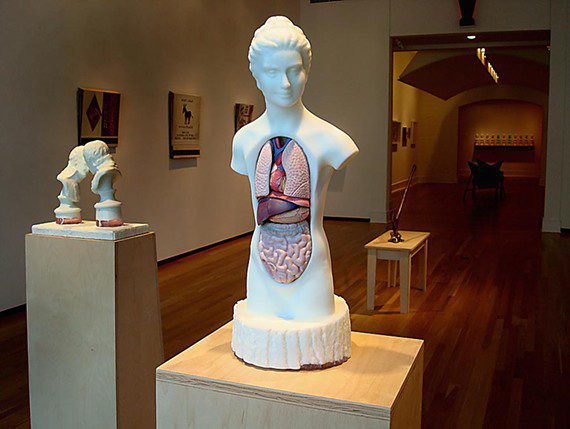D. Eric Bookhardt on Stephen Paul Day’s mixed-media works
by D. Eric Bookhardt

What do the rise and fall of empires have to do with Las Vegas? Probably not much except that both are marked by glamorous and grandiose symbolism. History is a roll of the dice, and somebody always loses. Empires were often fueled by visions of vast wealth, yet they eventually crumbled. Stephen Paul Day’s Blame It On Vegas exhibition actually focuses far more on European history than it does on Nevada’s Sin City, which is mostly represented here by his oversized paintings of tacky souvenir matchbooks. By contrast, his sculptures often feature mini-renditions of major figures in European history. In Virus, Adolph Hitler appears as a little mannequin frozen in a Roman salute in a foggy glass bubble. In the smallish bronze sculpture Michael, a morose child appears surrounded by chess pieces comprising scowling military men. In Louisiana, we grew up with allusions to Napoleon in the form of avenues, cafes and even our legal code, but in Day’s General Strategy, Napoleon appears as a row of pastel candy-colored busts on a shelf. This interplay of grandeur and tackiness is an ongoing theme.
Day’s attempts to link Vegas with European historical figures can seem far-fetched, yet he appears obsessed with finessing the contradictions of his romantic yet nihilistic outlook, and his work is often so finely wrought that it is seductive. Lady Fingers (pictured) is a glass female figure finished like white marble, and it would be quite neoclassical if not for her unexpectedly exposed inner organs. Napoleon, the romantic egomaniac, reappears as two identical glass busts kissing in a mingling of flashy attitude and classical craft comparable to snips of Beethoven’s Third Symphony sampled in a rap song. And then there’s Day’s wall sculpture Mirror: six assault rifles rendered in reflective gold glass arranged in a row. Is it a comment on the 2013 version of the American dream, or is it just Day up to his old tricks? — D. ERIC BOOKHARDT
